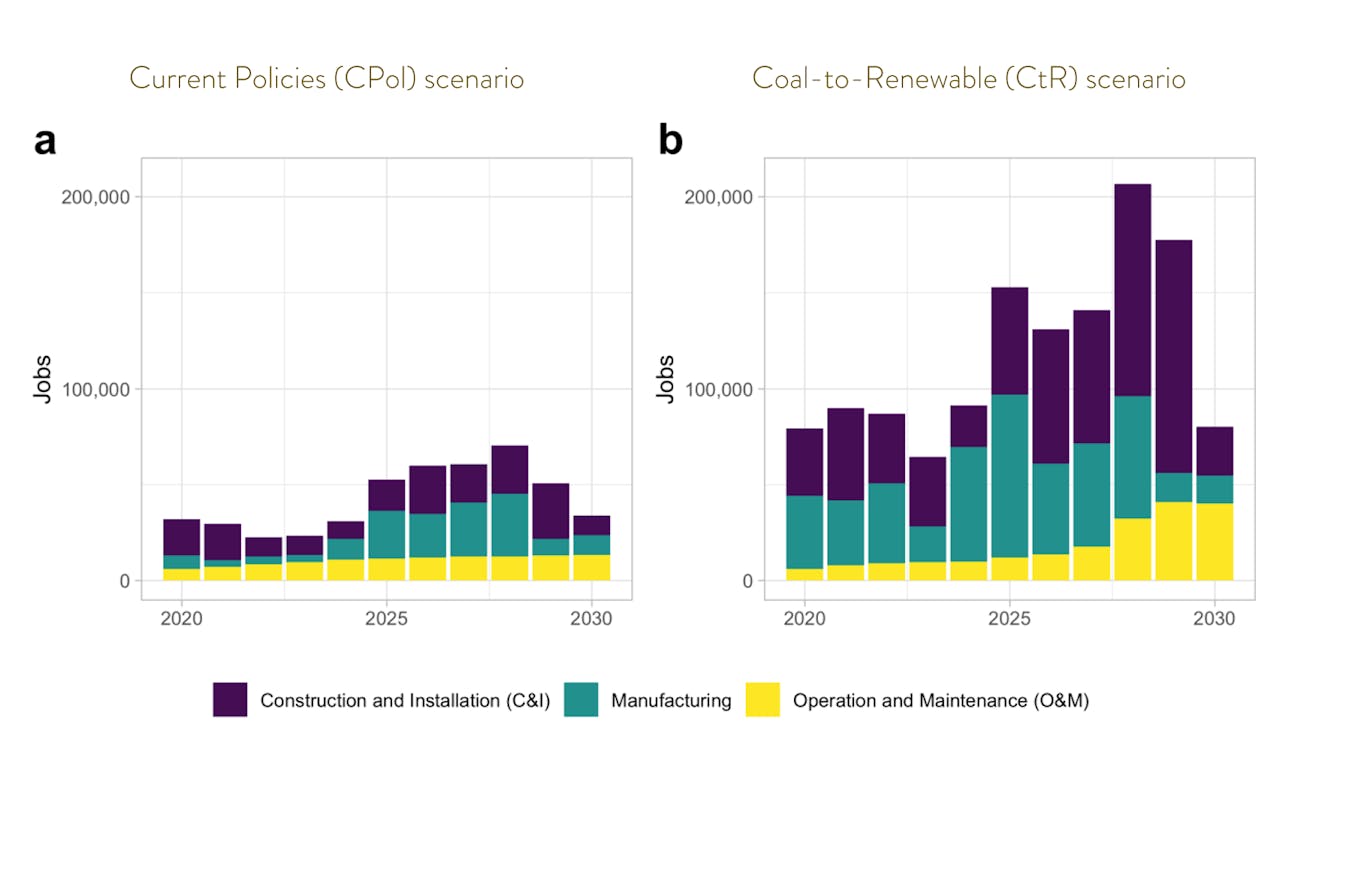Phasing out coal power in South Korea by 2029 in alignment with international climate goals and replacing the dirty fuel with solar, wind and storage could deliver nearly three times more direct jobs this decade than current policy plans, according to a new analysis released today.
To continue reading, subscribe to Eco‑Business.
There's something for everyone. We offer a range of subscription plans.
- Access our stories and receive our Insights Weekly newsletter with the free EB Member plan.
- Unlock unlimited access to our content and archive with EB Circle.
- Publish your content with EB Premium.
The report, by Seoul-based climate policy group Solutions for Our Climate and Berlin-headquartered research organisation Climate Analytics, debunks long-standing fears that consigning fossil fuel burning to the past too soon, could have detrimental effects on labour markets and the economy.
It finds that employment opportunities in emerging green energy are forecast to outweigh job losses from coal plant closures in all provinces and metropolitan areas across the East Asian state, even those heavily reliant on the coal power sector.
“The overall job creation potential in the operation and maintenance of newly installed renewable and storage installations alone could outweigh the job losses from closing all coal power plants across South Korea by 2029,” the report said.
Coal provinces like Incheon and Gangwon-do could boost employment by at least 1.3 times, Chungcheongnam-do and Gyeongsangnam-do 1.4 times, and Jeollanam-do over three times, if local clean energy potential is tapped more rapidly than current policies envisage.
On average, an accelerated move away from coal could create more than 62,000 additional jobs annually over the next five years, and more than 92,000 jobs per year in the second half of this decade, the new study shows.
Initially, most of the growth is likely to occur in utility-scale solar and storage jobs, with a rapid employment increase expected in rooftop solar and small-scale storage, offshore wind, and hydrogen later this decade.
Manufacturing, construction and installation will at first make up the lion share of green jobs created, but operation and maintenance are predicted to play an increasing role towards the end of the decade, generating long-term employment.

The study compared employment impacts in a current-policy scenario and an accelerated-coal-to-clean energy scenario. With the right policies, long-term maintenance and operations jobs in clean energy alone could far outweigh coal job losses, it finds. Image: Climate Analytics, Solutions for Our Climate
Seukyoung Lee, a researcher at Solutions for Our Climate, said the findings showed that replacing coal with clean alternatives this decade will benefit both the climate and the economy, and that key to achieving an energy transition that is both fast and fair, an issue that has been central to recent coal exit debates, is to bring workers along.
“As South Korea’s new carbon neutrality committee considers various emissions scenarios, there has also been discussion about policy measures to address labour concerns related to a faster energy transition,” she said.
“These findings should catalyse discussions on the country’s coal phase-out date and how national and subnational governments and businesses can support targeted training and retraining of workers in the coal industry,” she said.
The report findings reflect other recent studies highlighting the clean energy industry’s vast employment potential.
For instance, a recent analysis by the Institute for Energy Economics and Financial Analysis, an energy finance think tank, estimates that renewables projects presently in the pipeline in the Philippines will generate more than 350,000 jobs by 2030.
A 2019 report by consultancy McKinsey Sustainability found that in Vietnam, a renewables-led pathway would be cheaper than current energy plans and could potentially create an additional 465,000 jobs through to 2030, roughly twice as many jobs for the same level of investment as current plans.
The analysis comes as pressure mounts on South Korea to take tougher measures to cut planet-heating greenhouse gas emissions to achieve its goal of going carbon neutral by 2050, an objective President Moon Jae-in announced last October.
A 2020 study by Climate Analytics showed that South Korea must stop combusting coal to generate electricity by the end of this decade to keep emissions compatible with the Paris Agreement’s target to limit heating to well below 2, preferably to 1.5 degrees Celsius, compared to pre-industrial levels.
But under the government’s latest power development blueprint, the 9th Basic Plan for Electricity Demand and Supply, 27 gigawatts of coal power capacity will still be online in 2034, with the last plant to shut by 2054, 25 years too late for South Korea to play its part in global efforts to avert runaway climate change, campaigners say.
South Korea was the world’s 9th largest carbon emitter in 2019. Its economy’s high dependence on coal power, which accounts for 40 per cent of total electricity generation, has been a key barrier to climate action.
Last December, South Korea set a target for renewable energy to take up nearly 42 per cent of its power generation capacity mix by 2034.
But while it has channelled more investment towards offshore wind and solar energy, climate campaigners lament that growth remains sluggish. At present, renewables account for only 7 per cent of the power mix. Solutions for Our Climate says clean energy capacity must grow seven-fold by 2030 and 20-fold by mid-century to achieve the country’s carbon neutrality goal.
Last month, the country’s ruling party proposed a target to slash carbon emissions by at least 40 per cent compared to 2017 levels. While a substantial increase in ambition, the goal sits far below recently updated pledges by other developed nations such as Japan, the European Union, and the United States.
South Korea’s current 2030 commitment under the United Nations climate talks is to reduce emissions by 24.4 per cent below 2017 levels, a target rated as “highly insufficient” by climate policy research group Climate Action Tracker.








